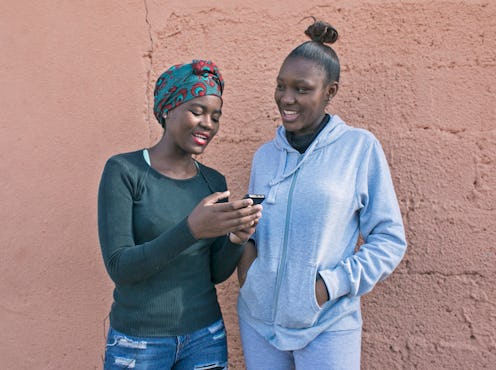Life
Girls Have WAY Less Access To Mobile Tech Than Boys, According To A New Study

The functions of mobile phones are vast and ever expanding: they're instrumental to our social and work lives, provide entertainment, and can facilitate learning, for a start. But a mobile technology gender gap exists, denying women and girls the many benefits of mobile internet and mobile phones. So are smartphones sexist? A new study conducted by non-profit Girl Effect and the Vodafone Foundation surveyed over 3,000 adolescent girls and boys across 25 countries to understand their access to and use of mobile technology. Their conclusion? Girls' access to mobile phones is "complex," influenced by varying factors including gender norms and financial capacity.
The Real Girls, Real Lives, Connected report, released to coincide with International Day of the Girl, takes figures from the GSM Association (GSMA) as its foundation; the GSMA Mobile Gender Gap Report 2018 says that in "low-income" and "middle-income" countries, 184 million fewer women own a mobile than men. What's more, the report finds that "women are, on average, 26 percent less likely to use mobile internet than men."
Girl Effect and the Vodafone Foundation's report focused specifically on adolescent girls' access to mobile technology, drawn from interviews and online surveys conducted in countries including the U.S., Colombia, Malawi, the Philippines, Rwanda, India, Nigeria, and Bangladesh. They concluded that both gender and age strongly impact the likelihood of a teenager to own a phone.
Data averaged from Rwanda, Malawi, Tanzania, Nigeria, India, and Bangladesh indicates that boys are 1.5 times more likely to own any phone, and 1.8 times more likely to own a smartphone than girls (with U.S. data included, boys are 1.44 times more likely to own any phone and 1.6 times more likely to own a smartphone). Teenagers aged 18 and 19, meanwhile, are more likely to own a phone than teenagers between 15 and 17.
What's more, boys are more likely to perform a wider range of activities using a phone, the survey discovered. And in Bangladesh, India, Malawi, Nigeria, and Rwanda, boys are more likely to perform activities that need an internet connection.
The survey also found that girls are more likely than boys to borrow phones, particularly in areas where access is restricted because of their gender. Parental concerns and social norms can limit girls' access: 47 percent of girls surveyed said they didn't own a phone because their parents were concerned about their safety, for instance. (However, many girls also reported that they were given a phone so they could contact their family in an emergency.)
Cost can also be prohibitive to female ownership: 42 percent of girls interviewed by Girl Effect ambassadors said handset price prevented them from owning a phone, while 13 percent cited the cost of data. Others said they lacked people to learn the many uses of a phone from: "The first [barrier] is that they don't know and even don't have someone to teach them," an 18-year-old from Rwanda said.
Mobile access, the report argues, correlates with female agency. Globally, girls reported perceiving mobile technology as "a gateway to the world"; this, however, could be viewed as either a negative or a positive. One 19-year-old woman, from Bangladesh, said, "We can connect globally, get to know more about what we are studying, and we can learn many things through the Internet...We can know about things that are unknown to us." An 18-year-old woman from India cited the facilities available to her after buying a mobile phone: "I do online exams, fill in application forms, send emails," she said. A 19-year old respondent from India, however, said, "Smart phones have bad videos and other obscene material is there that pollutes their mind. And they talk with boys on over Whatsapp, which they hide from their family."
So how can the mobile gender gap be addressed? Girl Effect and the Vodafone Foundation offer multiple suggestions. It's important to acknowledge, the study authors say, that mobile access "is often fluid and related to complex socio-economic factors" — essentially, it's more complicated than whether girls own phones or not. Tech literacy and digital safety should be incorporated into education, they suggest, while online platforms should allow for girls borrowing phones rather than owning outright. Mobile technology should also consider differing levels of tech literacy, while existing development programmes for girls should incorporate mobile technology.
What's more, girls should be supported "to expand their own digital horizons," Girl Effect and the Vodafone Foundation argue; specifically, they should play a fundamental role in tech design. Why? "Girls are better placed than anyone else to design tech solutions to improve their own lives," the study authors say.